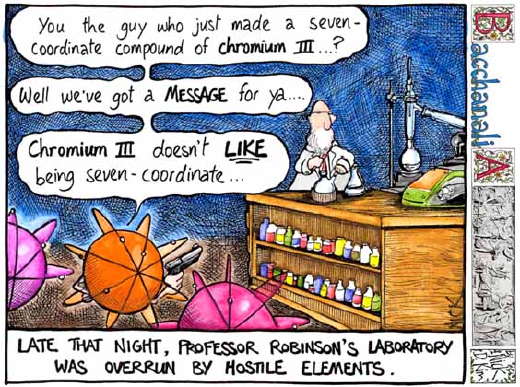The last edition of the Mailbag seems to have been a popular addition to the site, so I am running a sequel. Keep the questions coming!
Dr. Todd,
I have been wondering for sometime when manufacturers
of metal baits started to use Chrome for plating some of their lures. I have a Chapman Safe Deposit that looks like it is chrome plated. I plate with silver and nickel in making some of my own baits and I know that this Chapman is not silver or nickel plated because it is just so shiny but weathered and old at the same time.
What do you think?
Philip A.
A great question to which I believe there is not a definitive answer. According to George Dubpernell’s “A History of Chromium Plating” (Plating & Surface Finishing, June 1984), chrome plating first came into widespread use in 1928, the fundamental principles of chromium electroplating not having been discovered until 1924. It wasn’t really popular until the early 1930s.
Theoretically it is possible it was used on lures in the 1880s and 1890s, and Chapman, being one of the largest of the manufacturers, might have done it. But it does not appear that it was likely that they did.
Chromium plating is a type of electroplating, which was invented in 1805 by Italian scientist Luigi V. Brugnatelli (don’t believe all the hype about “ancient batteries” as they are pure speculation). The inventor of the Bunsen burner (R. W. von Bunsen) actually produced limited samples of electro-deposited chromium in 1854 using chromium chloride solutions. Electroplating itself was a widespread industrial technique by the 1860s, with the British (of course) taking the lead and America following in the 1870s, but chrome was not one of the substances used. Chrome really became a household name in the 1940s and 1950s due to its use on automobiles.
So is your Chapman chrome plated? In a short answer: no. So, if it isn’t nickel or silver, what is it? German Silver perhaps (a nickel alloy), or burnished aluminum? Any speculation would be greatly appreciated…

References:
Dartmouth College has a great web site about chromium.
The Finishing Industry’s cool home page has lots of info on electroplating.
Web Elements Periodic Web Table
Hello Dr. Todd,
I picked up a reel at this years [ORCA] national that I have a couple questions on.
It is exactly the same as a four brothers regal in every way. The markings on it are congress which if I remember is for Supplee-Biddle but above Congress there is a trademark I don't recognize.
It is a fish with an arrow through it. The fish points up at a slight angle and the arrow is horizontal.
Can you tell me anything about this reel as far as what that trademark is and what time period it came from? I would guess the late teens or early twenties. If you need or want some pictures let me know.
Robin S.
Dear Robin,
This is one of my favorite logo reels, made for Supplee-Biddle of Philadelphia (as you mentioned). It dates from the late 1920s or early 1930s, based on the three examples I own in my own collection.
The “speared fish logo” was actually originated by Supplee Hardware before they merged with Biddle Hardware around the start of WWI. It is one of the most distinctive and attractive logos, used on rods, reels, lures, ephemera, etc.
Interestingly, I believe these “speared fish logo” reels were brought in to fill the enormous gap left by the end of the Montague trade line (which began to be phased out in 1929 and culminated with its end in 1931). Shakespeare, like the one pictured, and Pflueger, like the one you own, stepped in by producing these beautiful trade reels for Supplee-Biddle.
References:
Dr. Todd E.A. Larson, “The Mark of Congress: The Fishing Tackle of the Supplee-Biddle Co.” (NFLCC Magazine, June 2006).
Hello!
I have an authentic first edition (1881) of the original "Book of the Black Bass" by James A. Henshall, M.D. of Cynthiana, KY (and also Cincinnati, OH). It's in excellent condition, and very rare. I was researching the book when I found your website…When I received the book, I discovered, tucked away between the pages, two newspaper clippings from 1963 and 1964. The first article was about the AFTMA naming an award after Henshall, the second is about the unveiling of a historical marker commemorating Henshall, near Cynthiana. I live in Georgetown KY, about 15 miles from Cynthiana, and have seen this marker myself.
-- Margie B.
I love Henshallania, as we call anything related to Dr. James Alexander Henshall. I was not aware there is in fact a historical marker in Cynthiana, Kentucky devoted to the father of bass fishing in America! I discovered that it is located in Cynthiana, south of the I-27 bridge, and is Kentucky Historical Marker #651. Here is a photo of this cool marker, courtesy of the State of Kentucky:
Your First Edition should be worth good money as there were probably no more than 2500 copies of the first edition printed (and most of those sold by pre-order). It is one of the seminal works in American fishing history. As a Cynthiana native, it may interest you to know that he devotes a lot of space in his autobiography to his Civil War years spent there.
References:
The Autobiography of Dr. James A. Henshall , edited by Clyde Drury.
That’s it for this edition of Dr. Todd’s Mailbag!
-- Dr. Todd
No comments:
Post a Comment